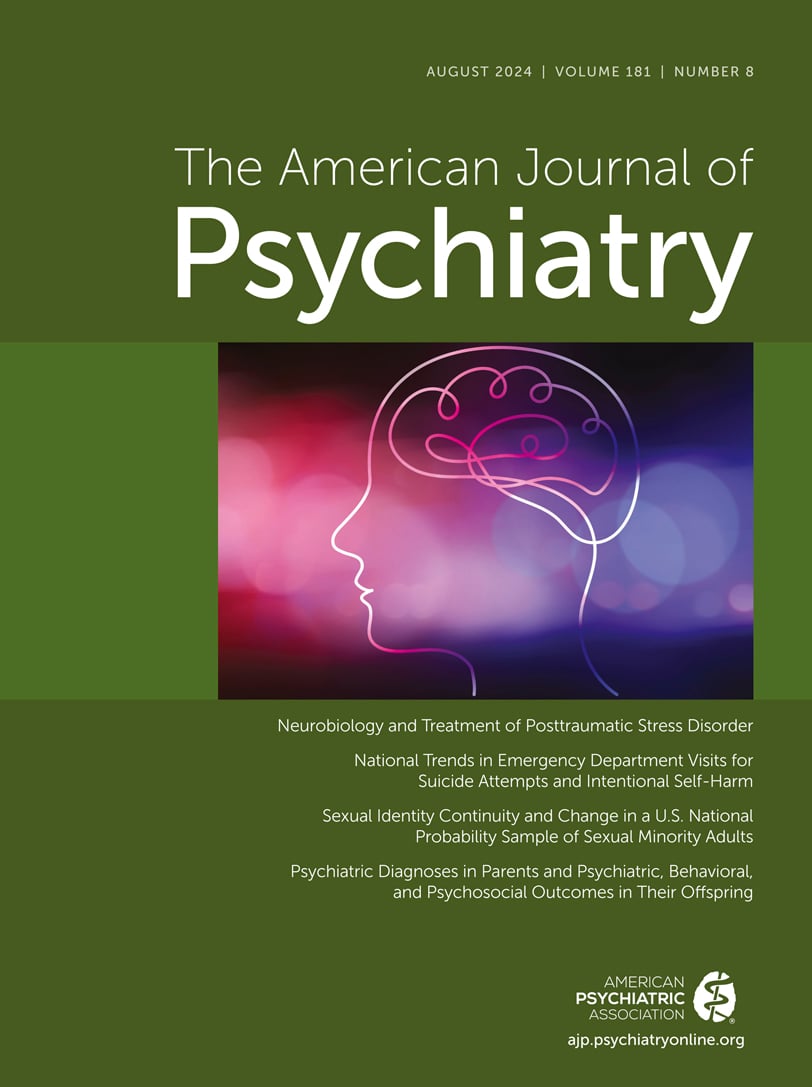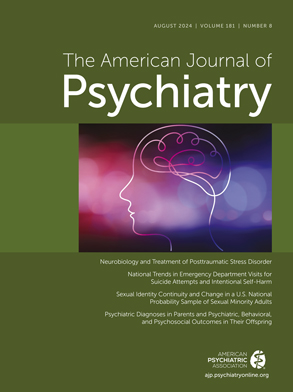Posttraumatic stress disorder (PTSD) is a complex psychiatric condition that develops in response to experiencing or witnessing traumatic events. Characterized by symptoms such as intrusive memories, heightened reactivity, and emotional numbing, PTSD can profoundly impact an individual’s daily functioning and quality of life. However, PTSD does not affect everyone equally; significant differences are observed based on sex, with women being approximately twice as likely to develop PTSD compared with men (
1). This disparity prompts a significant question: What underlies the variation in PTSD prevalence between the sexes?
Understanding the genetic and environmental factors associated with PTSD is crucial to elucidate the mechanisms that contribute to sex differences in PTSD. Genetic research, particularly twin studies, offers insights into how genes and environment interact to influence the risk and resilience factors associated with PTSD (
1). The study by Amstadter et al. in this issue (
2) advances our understanding of PTSD’s genetic underpinnings, particularly regarding sex-specific heritability. Utilizing a large data set of over 16,000 twin pairs and 376,000 sibling pairs from the Swedish Twin Registry, the study is the largest of its kind, delineating the genetic and environmental contributions to PTSD in the two sexes. Amstadter and colleagues have provided robust evidence that PTSD is more heritable in females (35.4%) than in males (28.6%). Furthermore, they introduce the concept of qualitative sex differences (i.e., differences in the genes underlying the heritability), showing that although the genetic factors contributing to PTSD are highly correlated between the sexes, they are not entirely the same (genetic correlation [r
g]=0.81). The qualitative sex differences suggest some sex-specific variant associations, potentially due to genetic variants leading to different downstream effects among males and females.
Higher rates of PTSD in females compared with males can be attributed to both environmental and genetic factors. A higher molecular-based heritability of PTSD in females was supported by an earlier genome-wide association study (GWAS) by the Psychiatric Genomics Consortium for PTSD (
3), but not by their most recent report, published earlier this year (
4). The conflicting findings on sex differences in molecular-based heritability of PTSD highlight the importance of twin studies for describing sex differences in risk for PTSD. While GWAS is excellent for pinpointing specific genetic variants associated with traits and diseases, twin studies offer a broader perspective on the genetic architecture by incorporating both genetic and environmental influences. Compared to GWAS, which typically estimates only additive genetic effects (i.e., effects of individual genes summed up), twin studies allow estimation of both additive and non-additive genetic effects, such as dominance and epistasis, where the effect of one gene depends on the presence of another. Hence, there usually is a gap in accounting for heritability between current GWAS estimates and twin studies, as GWAS often captures only a portion of the genetic variance that twin studies estimate. While prior twin studies have laid the groundwork by establishing PTSD’s moderate heritability, they have often grappled with limitations such as small sample sizes, homogeneous populations, and reliance on self-reported PTSD symptoms, which could introduce biases such as recall inaccuracy (
5). In contrast, the twin study by Amstadter et al. leverages a national registry and inclusion of sibling pairs, enabling access to a diverse and extensive population sample that provides a more objective and comprehensive assessment of PTSD heritability. This approach not only enhances statistical power but also reduces the potential bias inherent in studies reliant on self-reported measures of PTSD.
The findings from the Amstadter et al. study have significant implications for both the theoretical understanding of PTSD and its clinical management, particularly through the lens of sex differences. The demonstration of quantitative sex differences—where heritability is significantly higher in females—suggests that genetic factors may play a more pronounced role in the development of chronic PTSD among women. This knowledge could guide more personalized approaches to prevention and treatment, potentially leading to the development of interventions that are tailored to the unique genetic profiles of individuals based on their sex. Furthermore, the qualitative sex differences that were identified, indicating that different sets of genes may influence PTSD risk in males and females, pave the way for exploring sex-specific genetic pathways that contribute to PTSD. This could lead to the identification of novel mechanisms and biomarkers for PTSD that are specific to each sex, both of which may facilitate earlier and more precise interventions for PTSD. Additionally, understanding these pathways could help in the development of new sex-specific pharmacological treatments that target these specific genetic mechanisms. This is especially true for genetic mechanisms that may interact with gonadal steroid hormones, such as estrogen, across the lifespan to confer risk and resilience to PTSD by impacting the neurocircuitry underlying fear extinction deficits and symptoms characteristic of PTSD (
6). This is particularly important for trauma-exposed women, whose PTSD symptoms can be impacted by fluctuations in ovarian hormones during the menstrual cycle (
6), pregnancy (
7,
8), and the menopause transition (
9).
Emerging evidence indicates that estrogen receptor genomic actions modulate PTSD risk in women by affecting the pituitary adenylate cyclase–activating protein receptor (PAC1R) in the limbic system (
1). Notably, the SNP rs2267735, within a potential estrogen response element of the PAC1R gene (
ADCYAP1R1) affects fear responses and PTSD severity in adult females but not in males (
10). This variant disrupts the regulatory function of estrogen, leading to impaired neural signaling in fear-related circuits, and is associated with reduced neural connectivity and activity in the amygdala and hippocampus after exposure to fear stimuli (
11). Estrogen also influences epigenetic processes that regulate gene expression in brain areas critical for stress responses (
12). Studies have shown that estrogen levels correlate with DNA methylation changes across the genome, impacting genes involved in PTSD and fear regulation in females (
13). For instance, increased methylation at a CpG site (cg22937172) in the histone deacetylase 4 gene (
HDAC4) is associated with PTSD and lower estrogen levels (
13). Additionally, a nearby SNP, rs7570903, is associated with increased
HDAC4 methylation, which reduces its mRNA expression, leading to heightened fear responses and impaired fear extinction in carriers (
13). The evidence collectively highlights a gene-by-environment-by-estrogen interaction that contributes to sex-specific PTSD risk.
While the study by Amstadter et al. offers profound insights into the genetic and environmental underpinnings of PTSD, it also underscores several areas for further research. One notable limitation is the reliance on diagnostic codes from medical records and registries, which may not capture trauma exposure or the different types of PTSD symptoms. Future studies could benefit from incorporating more detailed, individual-level data on trauma types and PTSD symptoms to better understand the interactions between specific trauma exposures and sex-specific genetic risk. Additionally, while the Amstadter et al. study has made significant progress in identifying sex differences in genetic effects on PTSD, the exact genetic markers and their mechanisms of action remain largely unexplored. Further research is needed to pinpoint specific genes or genetic networks that contribute to these differences. Such studies could involve GWASs that are stratified by sex to uncover potential sex-specific genetic variations linked to PTSD, followed by functional studies in animal models to characterize sex-specific mechanisms influenced by these variations. Another promising area for future research is the exploration of environmental factors that interact with genetic risk. Understanding the gene-environment interplay is crucial, as it could unveil triggers or protective factors relevant to developing targeted prevention strategies. This approach would also align with the growing interest in personalized medicine, which aims to tailor health care based on individual genetic profiles and environmental exposures. Finally, as the findings suggest substantial sex differences in the genetic architecture of PTSD, it is critical to extend these findings to diverse populations, many of which also suffer disproportionately from PTSD (
14,
15). Such diverse studies would help to determine the generalizability of the findings across different ancestries and ethnicities.
In summary, the study by Amstadter et al. significantly enhances our understanding of PTSD by revealing genetic factors that contribute to its development and demonstrating the importance of considering sex differences in its genetic architecture. The findings underscore the promise of integrating genetic findings into clinical practice, paving the way for more personalized approaches in the treatment and prevention of PTSD.

